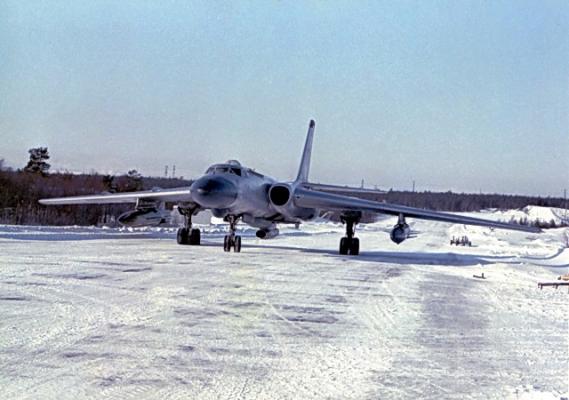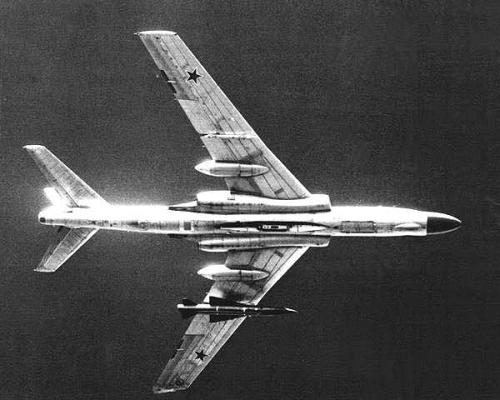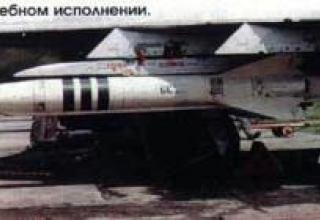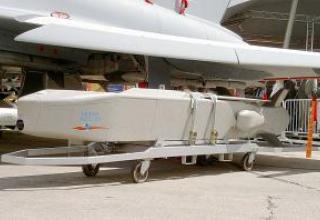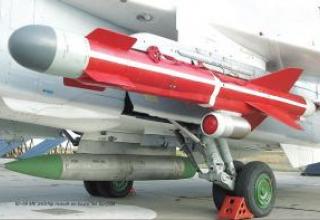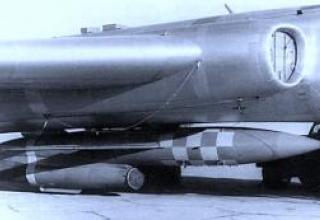The KSR-5 (D-5) cruise missile as part of the K-26 is designed to engage radar-contrast naval (surface ships) or ground (bridges, dams, power plants) targets.
Resolution of the USSR Council of Ministers on the creation of a missile armament system KSR-5 with the control system "take-off", was released on August 24, 1962. It was given a launch range of 180-240 km and the missile speed 3200 km / h at an altitude of 22500 m.
The K-26 complex was developed at the Rainbow Design Bureau using the experience of the X-22 missile. Flight tests of K-26 complex began on two aircraft in October 1964. At the Tupolev pilot plant № 156 under it re-equipped serial machines produced by the Kazan aircraft factory - Tu-16K-11-16KS № 8204022 and Tu-16KSR-2A № 5202010, produced almost 10 years ago. Factory tests were delayed for almost two years, and on joint with the customer state testing complex was withdrawn only in January 1967. The results of the first phase of the tests with launches on sea and land targets were considered unsatisfactory due to the low accuracy of application on ships, dictated by deficiencies in the control system.
After improvements the K-26 complex was again presented for state testing, during which 87 flights were performed. Tu-16K-26 No. 4200703 was also involved in the tests, and since the end of 1968 it has been re-equipped from Tu-16K-10-26 missile carrier No. 1793014. During the tests completed by November 30, 1968, 13 missile launches of KSW-5 were made against sea and ground targets. The launches were carried out at launch vehicle speeds of 400-850 km/h and altitudes from 500 to 11000 m. At the same time, the launch range significantly depended on the flight mode under the conditions of target detection of the onboard radar and the capture of the missile's SST. Thus, at an altitude of 11000 m, the radio surveillance sector was significantly higher, and target acquisition was carried out at a distance of 300 km, with a flight altitude of 500 m, the launch range did not exceed 40 km. Tests of marine Tu-16K-10-26 continued until spring next year, after which November 12, 1969 aircraft and missile systems K-26 and K-10-26 were adopted by the YES and the Navy.
On the basis of the KSW-5, there was also created an upgraded version of the K-26M KSW-5M complex for fighting small complex targets, which had improved accuracy characteristics and a low-altitude K-26H complex with KSW-5H missiles. Owing to limited visibility from low altitudes and low resolution, which limited the capabilities of the system, it was necessary to upgrade the search and target system. On 14 aircraft installed a panoramic radar system "Ercut" IL-38 aircraft under an enlarged fairing. These cars entered the Baltflot aircraft. A more radical solution was the use of the new radar "Rubin-1M", created in 1973 on the basis of "Rubin-1KB" and has an increased range of detection and improved resolution. Its antenna system was very large, with a large gain and a one-and-a-half times the width of the directivity diagram. The detection range of marine targets reached 450 km, but the large antenna and the need for layout volumes for the equipment required the radar to be moved from its normal location to the cargo area, under which a large droplet-shaped fairing was mounted. Another distinguishing feature of such machines was a smooth nose part, deprived of the previous radar. To save weight, the nose gun was removed, and the fuel system was reduced to tank number 3, which was replaced by the equipment units.
The need for a modern anti-radar missile was reflected in the Resolution of the CM dated February 7, 1964, which tasked the creation of the K-26P complex with KSK-5P missiles equipped with passive SLN. The search for radiating targets was carried out with the help of the aircraft radar reconnaissance station and target designation "Ritsa" (also called passive radar) and associated reconnaissance equipment of working radars. The control and guidance system also included passive missile homing equipment and autopilot. The antenna unit "Ritsa" was placed on the glazing frame of the navigation cabin, in which indicators were mounted, which displayed information about the position and characteristics of the guided radar, as well as the readiness of the system for missile launch.
Experienced Tu-16K-26P came out on factory tests in the summer of 1967, after a number of improvements in April 1972, it was presented to the state testing. Resolution of the CM of September 4, 1973, the K-26P system was adopted in service of naval aviation, and since 1975 at the repair plants began re-equipment of aircraft on the model of Tu-16K-26P. K-26P complex allowed to hit the radio-emitting targets by single and volley launches of both missiles in one go, as well as to perform attacks on two different targets - one lying on the course of flight, and the other, located in the 7.5 ° from the axis of the aircraft. Rockets after launch were fully autonomous, not limiting the aircraft in maneuver.
In addition to the anti-radar missiles of CEB-5P, the complex provided for the use of CEB-11 for similar purposes and maintained full attack capabilities using the missiles of CEB-5, CEB-2 and bomb weapons. With the advent of the modernized KSW-5M, the capabilities of the complex were expanded and it was named K-26PM, differing in the installation of improved target designation equipment for missile heads.
The low-altitude KSK-5H missile became the basis for the development of KSK-5NM (D-5NM) and KSK-5MV (D-5MV) cruise missiles in low- and high-altitude versions. The targets simulated the flight of various types of enemy missiles of "air-to-surface" classes, developing speeds up to M=4.2 at altitudes up to 40 km. Used to test the latest SAMs targets were launched from carriers Tu-16KRM, converted from conventional vehicles with enhanced shielding on the model of missile carriers and installation of holders BD-352-11-5. Tu-16K-26 missile carriers could also be used to launch targets.
For the development of the K-26 missile system the team headed by A.Y.Bereznyak was awarded the State Prize for 1970. The development of the K-26P complex was awarded the State Prize for 1977. Serial production of KKS-5 and its variants was set up at Smolensk Aviation Plant.
Tu-16A and Tu-16K-16 bombers were converted into KSK-5 missile carriers. The latter could also use KSK-2 missiles. The range of KSK-5 missiles was much higher than that of the carrier radar and did not allow the full potential of new missiles to be used. In this regard, in the area of the cargo compartment of the aircraft installed radar "Rubin" with an antenna from the search and target station "Ercut" with a range of target detection up to 400 km. Twelve carriers were re-equipped for the new radar.
In the future, the new complex was re-equipped Tu-16K-10 (Tu-16K10-26) for the Navy and Air Force - Tu-16K11-16 (Tu-16KSR2-5). For Tu-16K10-26 in addition to the standard missile K-10S / SNB under the wing of the carrier on the beam holders placed two KSR-5. In the 1970s it was the strongest aircraft anti-ship complex. Simultaneous application of low-altitude K-10 and high-altitude SKS-5 significantly increased the probability of target destruction.
For the development of the product D-5 a large group of employees of ICB "Rainbow" headed by A.Y. Bereznyak was awarded the State Prize for 1970.
Apart from the main one, there was also supplied a variant of the D-5H missile which had the same ARGSN as the basic one, but differed by a number of systems, including onboard power supplies. In 1972, the antisatellite KSR-5P was created. Its carrier Tu-16K-26P received the target designation station "Ritsa", which was installed on Tu-16KSR2-5. The Rainbow ICB "Rainbow" was awarded the State Prize for 1977 for the creation of the SRS-5P missile.
In 1967 works on retrofitting of 3M bombers with K-26 complex were started at the EMZ. The production plane 0305 received 2 BD-487, Rubin-1ME radar, target designation equipment for KSW-5P and SPS Azalia. Tests of the aircraft, called ZM-5, were successful, but the issue of extending the life of the aircraft was not resolved and work ceased.
In the early seventies, a similar refinement was one Tu-95M (Tu-95M-5, complex K95-26). In 1976, it passed the tests. In the beginning it was planned to finalize 33 aircraft Tu-95M, but because of the exhaustion of their resource it was not done.
At present, the combat versions of KSK-5, KSK-5H and KSK-5P missiles have been removed from service. In service remain several carriers Tu-16KRM, equipped with target missiles KSR-5NM and MB (low-altitude and high-altitude). KSKS-5 targets are designed to simulate the flight of aircraft and cruise missiles of various types, including small and subsonic in a wide range of numbers M and altitudes. Targets can be equipped with equipment registering the trajectory parameters of the attacking missile. Targets (as opposed to combat missiles KSW-5) are offered for export.
K-26 complex had significant capabilities and combat efficiency, allowing to hit both sea and ground targets (such as factory buildings, bridges, dams, bases and warehouses), the general condition was sufficient radar visibility of objects, which also responded to airfields, port facilities and railway stations. At the time of adoption of its missiles were virtually indestructible not only existing but also promising enemy air defense facilities, and this situation remained until the early 1980s.
The integrated use of missiles together with the anti-radar KS-5P missiles made the anti-aircraft capabilities themselves vulnerable - after the air defense was hacked, the advantages of an air strike group became even more evident.
In the west, the SAC-5 missile was designated AS-6 "Kingfish".
Composition:
According to the aerodynamic scheme KSR-5 - a monoplane with a mid-wing and plumage (see layout chart).
The KSK-5 missile has an all-metal construction with a working lining, a mid-planimetric arrangement of a small triangular wing and a cross-shaped plumage. The heel and pitch control was carried out by an all-terrain stabilizer, working in elevon mode, at the rate - all-terrain upper keel. To increase flight stability, the missile had a sub-body bottom keel, which folded to the right in flight during storage, transportation and suspension. The launch arrangement was provided by a pneumatic cylinder together with the rudders' unfolding by the firing clamp.
The main structural materials of the airframe of the rocket were stainless steel EI-654 (oxidizer tank), 30ХГСА and 12Х2НВФА (power units of plumage and butt elements), alloys АМГ-6Т (fuel tank) and Д16Т (part of the shells and panels). Heat-resistant steel 1 2ХНВФА was also used to make a sock of the rocket fairing that was heated in flight to 420°. Large hull units were all-welded, wing and plumage were made with a wide use of honeycomb panels made of thin aluminum foil, which for strength and rigidity were poured molten xylite, and then processed along the theoretical contour on a vertical milling machine using a copier. Large-size coloured castings were widely used for the production of power frames and equipment fastening beams.
A number of problems were caused by the manufacture of radio transparent fairings - large-size products, which at high supersonic aerodynamic and thermal loads should have the necessary mechanical strength, thermal and moisture resistance, high surface purity, low weight and, most importantly, the proper radio transparency, which was subject to particularly stringent requirements. The latter had a direct impact on the characteristics of CNS, which required a radio transmission coefficient of 70-75%. Experiments and searches for the technology of manufacturing the lightest in the required radio range of the fairings, carried out by leading engineers of plant № 256 V.N.Lezhenin, L.E.Kuznetsova, A.S.Kazakov and specialist VIAM K.T.Scherbakova were required.
The practice of manufacturing solid fairings for X-22 from glass fiberglass has shown that they have too much weight. The fairing of almost two meters in size with the required strength and rigidity should have a small weight, but precisely defined contours. For radio-transparency requirements, wall thicknesses were limited to 4-7 mm. The cone had a honeycomb structure with mesh filler, and the thickness varied from larger at the toe to thin at the base. For the production of its outer and inner jackets steel punches were used, on which fiberglass coverings were molded under vacuum. On the same punch, a mesh mesh mesh was glued to the inner shirt, molded along the contour, and then the outer shirt and power belt were put on at the base. The final polymerization of the bundle with curing of the binder resin for strength was carried out in the furnace in accordance with the stepped temperature regime.
The problem was the design of the balloons that fed the missile's steering drives and the boost system. The balloons were made of two thin-walled 5-mm thick chromancer hemispheres, which were welded together. Cylinders had to withstand a working pressure of 350 atm, but the products were not always durable. In operation, there were a number of cases of their explosion, which destroyed the structure, with the engine and tanks nearby, which led to a fatal outcome for the entire product and was extremely dangerous for personnel. Cylinders - "bombs" were not trusted until they were reinforced by winding fiberglass bundles on the body. This design withstood pressure of up to 700 atm, allowing to reduce the thickness of the walls to 4 mm, and at the rupture did not give splinters, splitting into halves.
The nose section of the missile was occupied by the VS-KN homing equipment with active radar CNS. With the help of aircraft target designation CNS captured the target on the suspension, tracking its position on the azimuth. The control system - "take-off" provided homing on course and pitch and software control of altitude, which provides the output of the missile in the stratosphere with a subsequent dive on the target. Later on, the control system was improved to provide a counter-air maneuver in case of enemy radar irradiation.
The next compartment accommodated a 700 kg BC of blast-current type or a nuclear BC in a special container with all necessary equipment, including an explosive device that provides a specified ground or air blast, a safety and launch system with detachment sensors from the carrier and trajectory sensors, a temperature control system that maintains the necessary temperature and humidity in the compartment.
The central part of the missile was occupied by a fuel cell with fuel and oxidizer tanks. The fuel tank contained 660 liters of fuel and the steel oxidizer tank contained 1010 liters of oxidizer. The pressure of the tanks was provided by an air system that simultaneously served as the first stage of the feed system, it also used to inflate the waveguides and arrange the lower keel. The pipes of the inflatable system, feeder and wiring of the electric fittings were laid in the basement gargota under removable panels to provide access. "Dry" ampoule batteries with converter in the equipment compartment provided power supply to the systems for 480 sec. The low-altitude KSR-5H had a number of differences in the power system and storage batteries.
The missile was equipped with a C.5.33 type LCD designed by A.M.Isayev Design Bureau with two combustion chambers with separate exhaust nozzles. The supersonic nozzles are unregulated and each of them was optimized to create a certain thrust. The engine was powered by a common turbo-pump unit (TNA) with automatic mode adjustment, performing two programs with different traction. The high-performance TPA provided the required fuel consumption of 80 kg/sec and the required pressure at the engine inlet (the LPG thrust increases significantly as the operating pressure in the combustion chamber increases, and the feed pressure must exceed it to allow fuel to enter the engine). The dual-chamber design of the LRD, with its compact size and light weight, provided the required range of thrust required in various flight modes. When the rocket was launched, a combustion chamber began to operate, the thrust of which in 7100 kgf reported to the rocket thrust-to-weight ratio of 1.8 and provided a fast acceleration and altitude gain. To maintain the speed at altitude, a marching combustion chamber with an economical thrust of 600 kgf or 1120 kgf, depending on the set flight mode, was included in the work. The fuel was two-component: fuel TG-02 (660 l) and oxidizer AK-27P (1010 l). The air system of the missile provided the waveguides, oxidizer and fuel tanks, lower keel layout and other operations.
Modifications:
- CEB-5 (see projections) - basic version of the missile
- DAC-5H (see projections) - a low-altitude version of the DAC-5 missile, with the same AWARS as the basic but different from a number of systems, in particular onboard power supplies
- KSR-5P is a variant of KSR-5 equipped with passive radar CNS and designed to engage the radar (target acquisition range up to 400-450 km).
- KSR-5M is a missile for fighting complex small targets with increased accuracy.
- KSW-5NM is a low-altitude target missile.
- DAC-5MW - Target altitude missile
On the aircraft equipment the missile was compatible with the old complexes K-10 and K-11-16 based on the Tu-16, but for the suspension required reinforced holders BD-487.
The method of using the K-26 complex (see diagram) was similar to the K-16 in many respects. After detection of the carrier radar target, it was captured and auto-accompanied by the missiles' GSN, which was usually provided with a flight at an altitude of 10-11 km with a distance of 300 km. Taking into account the control operations and the time to take a decision, the launch boundary of K-16 from these altitudes was about 280 km. On command, the missile equipment was switched from power supply "on board" the carrier to its own ampoule batteries, and after 12-14 seconds, all missile systems were ready to launch. Descended from the suspension of the missile went down, moving away from the aircraft at a safe distance, while the disconnection served as a signal to detonate the BC fuse. The launch speed should have been in the range of 400-850 km/h. In the second second second of the flight the engine was started and the rocket started to gain speed, in the 15th second after the acceleration it went to the altitude set at the command of the autopilot software mechanism. Then the CLO was connected through the course channel, and with acceleration to the speed of M=3 the afterburning mode was switched off. At an altitude of 18000 m the missile began to stabilize at an altitude with the inclusion of the marching mode LCD and transition to a horizontal flight, performed at an altitude of 22500 m. As the missile approached the target of up to 60 km, it was diverted to a 30° dive (the dive command was generated by the autopilot at a 30° deviation of the radar antenna of the CNS radar coordinator, which corresponded to an inclined range to the object of about 60 km, and the distance-measuring device of the CNS with access to this distance duplicated the command in case of failure of the car escort).
When the distance to the target was reduced to 400-500 m, the autopilot switched to flight stabilization mode, maintaining its direction to avoid homing failure due to interference or "blindness" from a reflected signal. The CNS itself memorized previous target parameters when it was exposed to interference to avoid a malfunction. The guidance system of KSW-5 provided rather high accuracy, characterized by the value of probable circular deviation of 10-20 m (the same value was measured by the accuracy of KSW-5P). However, it was noted in the guidelines for combat use that the error can increase significantly in a well-organized radio electronic counter-measures by the enemy, and for anti-radar missiles - as a result of interference or termination of the radar.
Characteristics:
| CEB-5 | CEB-5P | CEB-5H | |
| Length, m | 10,52-10,56 | 10,56 | 10,56 |
| Diameter, m | 0,9-0,92 | 0,9-0,92 | 0,92 |
| Swing, m | 2,5-2,61 | 2,5-2,6 | 2,5-2,6 |
| Start weight, t | 3,952-4,5 | 3,952-4,5 | 3,944 |
| Guidance System | inertial + ARLGSN | inertial + PRNGN | inertial + ARLGSN |
| BC | OF or thermonuclear 350-500 kt | OF or thermonuclear 350-500 kt | OF |
| Weight BC, kg | 700 (900-1000) | 1000 | 900-1000 |
| Range of fire, km | 240-300 (400) | 300-400 | 250-400 |
| Flight Speed, km/h. | 3200 (3М) | 3200 (3М) | 3М |
| Flight altitude, km | 25-30 | 25-30 | 25-30 |
| Height of application, km | 0,5-11 | 0,5-11 | 0,5-11 |
| Fuel | TG-02 | TG-02 | TG-02 |
| Oxidizer | AK-27P | AK-27P | AK-27P |
| Rocket preparation equipment | Volga | Volga | Volga |
| target designation radar | Ruby-1KV | Ruby-1KV | Ruby-1KV |
| Airplane carrier | Tu-16K-26, Tu-16K10-26, Tu-95K-26, Tu-95M5. | Tu-16K-26P | Tu-16K-26, Tu-16K-10-26 |
Testing:
One of the first carriers of the complex is a multipurpose nuclear submarine of the project 885 "Ash", which belongs to the fourth generation of submarines. The keelmark in the series, called "Severodvinsk", took place on December 21, 1993. The boat carries 24 missiles in inclined launch shafts. The natural model of the new anti-ship missile in an export version (a variant for underwater, surface and shore-based), was first publicly demonstrated at the exhibition MAKS-97. It was also exhibited at MAKS-99.
The advertising passport for the small rocket ship of project 21632 "Tornado" (approved on 26.04.2008) indicates the possibility of placing the Yakhont complex as one of the weapon variants.
According to military analysts' forecasts, the Yakhont complex will have no analogues in the world for another 10 years. This can be proved by the interest expressed by foreign buyers. A number of countries of the Asia-Pacific region, the Middle East, which in the past bought Russian ships and boats with cruise missiles, have already become interested in the novelty of the domestic military industrial complex. PCR Yakhont also has good prospects in terms of upgrading foreign-built ships, where it can replace the Harpoon, Exocet, and Otomat anti-ship complexes.
Sources:
- История и самолеты ОКБ МиГ / ООО «Крылья России», АНПК «МиГ», 1999, CD-ROM / .
- «Морская ракетоносная» / Журнал «Авиация и космонавтика», N11-12, 1997г. /
- AS-6 Kitchen/FAS - Russian and Soviet Nuclear Forces
- Якубович Н.В. "Боевые самолеты Туполева", М.: Яуза: Эксмо, 2010.-528с.
- Марковский В., Перов К. "Авиационные крылатые ракеты" // Авиация и космонавтика. N 10 / 2005 г

